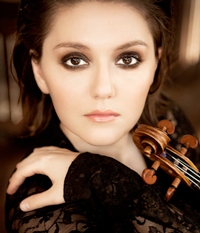by Daniel Hautzinger

The highlight of the night was Mozart’s Violin Sonata in e minor. Howsmon and Zhulla poignantly rendered the bare opening statement of the first theme, setting a mood of solemn pathos. The heartbroken melody of the second movement was wrenching, decorated by the most distinctive feature of Zhulla’s playing: her wonderful vibrato. Howsmon’s crystalline accompaniments provided stark relief for the emotive theme. When the music turns to major in the middle section, it is like a retreat into a comforting memory. But the solace does not last, as the pain of the present rushes back to end the piece.
Zhulla is a Lincoln Center Chamber Music Society Two Artist, making her a fitting coach for a string quartet. Yet surprisingly for a pairing of chamber musicians, she and Howsmon occasionally seemed unsettled in Ravel’s Second Violin Sonata. This led to some moments that were not quite in sync, though that may be partly blamed on Ravel’s tricky rhythms.
Despite any such minor difficulties, the performance was still an insouciant romp through Ravel’s version of the blues. The first movement again showcased Zhulla’s singing vibrato. The swanky second movement could easily fail in the hands of a shy performer, but Zhulla had the requisite panache to pull it off, bending phrases with a sly musical grin. And her technique shone while she imitated wind-up toys in the third movement.
The concert ended with another Ravel work, his virtuoso showpiece, Tzigane. The title is French for “gypsy”, and the work is peppered with the exotic melodies and fiddling effects one might hear in a gypsy camp. It opens with a combustible violin cadenza that Zhulla invested with energy and character. Ravel then exploits the idiosyncrasies of the violin with a variety of flashy techniques presented over colorful piano textures (the original piece called for a luthéal attachment for the piano, which allowed the pianist to alter the tone of the piano by pulling stops as on an organ). Howsmon dutifully mirrored Zhulla’s expansive liberties with time, keeping his sparkling accompaniments in line with her part.
Zhulla’s recital was a pleasant opening to Oberlin’s String Quartet Festival, and her interpretation of Mozart gave students much to learn from. Hopefully the remaining concerts will provide even more enjoyment and education.
Published on ClevelandClassical.com January 13
Click here for a printable version of this article.



